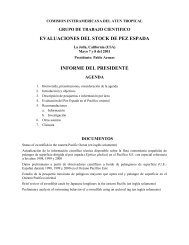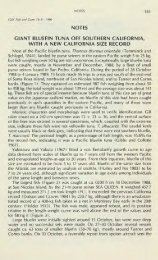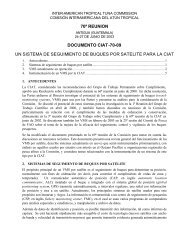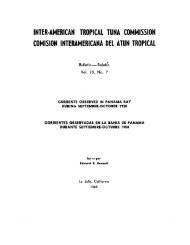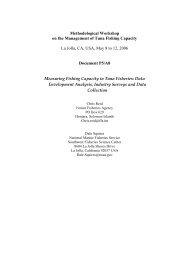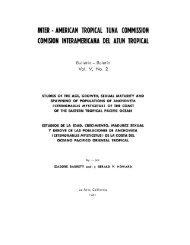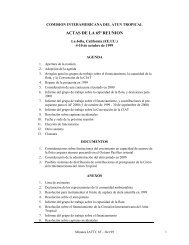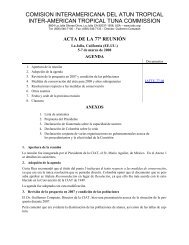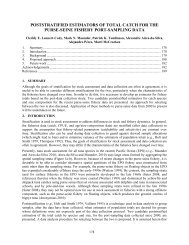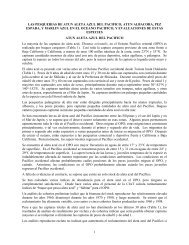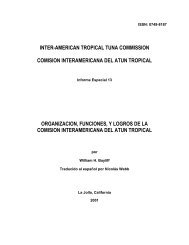INTER-AMERICAN TROPICAL TUNA COMMISSION - Comisión ...
INTER-AMERICAN TROPICAL TUNA COMMISSION - Comisión ...
INTER-AMERICAN TROPICAL TUNA COMMISSION - Comisión ...
- No tags were found...
You also want an ePaper? Increase the reach of your titles
YUMPU automatically turns print PDFs into web optimized ePapers that Google loves.
11ing the integrated modeling that the staff has employed during the last several years. The results of such studies have been describedin several IATTC Bulletins, in its Annual Reports for 1954-2002, and in its Stock Assessment Reports.Length-frequency samples of yellowfin, skipjack, bigeye, Pacific bluefin, and, occasionally, black skipjack from the catches ofpurse-seine, pole-and-line, and recreational vessels in the EPO are collected by IATTC personnel at ports of landing in Ecuador,Mexico, Panama, the USA, and Venezuela. The catches of yellowfin and skipjack were first sampled in 1954, bluefin in 1973, andbigeye in 1975. Sampling has continued to the present.The methods for sampling the catches of tunas are described in the IATTC Annual Report for 2000 and in IATTC Stock AssessmentReports 2 and 4. Briefly, the fish in a well of a purse-seine or pole-and-line vessel are selected for sampling only if all the fish in thewell were caught during the same calendar month, in the same type of set (floating-object, unassociated school, or dolphin), and inthe same sampling area. These data are then categorized by fishery (Figure A-5), based on the staff’s most recent stock assessments.Data for fish caught during the 2003-2008 period are presented in this report. Two sets of length-frequency histograms are presentedfor each species, except bluefin and black skipjack; the first shows the data by stratum (gear type, set type, and area) for 2008, andthe second shows the combined data for each year of the 2003-2008 period. For bluefin, the histograms show the 2003-2008 catchesby commercial and recreational gear combined. For black skipjack, the histograms show the 2003-2008 catches by commercial gear.Only a small amount of catch was taken by pole-and-line vessels in 2008, and no samples were obtained from these vessels.For stock assessments of yellowfin, nine purse-seine fisheries (four associated with floating objects, three associated with dolphins,and two unassociated) and one pole-and-line fishery are defined (Figure A-5). The last fishery includes all 13 sampling areas. Of the1,027 wells sampled, 630 contained yellowfin. The estimated size compositions of the fish caught during 2008 are shown in FigureA-6a. The majority of the yellowfin catch was taken in sets associated with dolphins and in unassociated sets. Most of the largeryellowfin (>100 cm) were caught throughout the year in the Inshore dolphin fishery, during the first, second, and third quarters inthe Northern dolphin-associated fishery, and during the first and fourth quarters in the Southern dolphin-associated fishery. Largeryellowfin were also caught during the first and fourth quarters in the Southern unassociated fishery. A small amount of large yellowfinwas taken in the Southern floating-object fishery throughout the year, and in the Equatorial floating-object fishery in the first andsecond quarters. Yellowfin, ranging from 40 to 60 cm in length, was evident in all the floating-object fisheries during the year, andin the first, second and third quarters in the Northern unassociated fishery. Small amounts of yellowfin in the 50- to 70-cm sizerange were taken by pole-and-line vessels, mostly during the third and fourth quarters.The estimated size compositions of the yellowfin caught by all fisheries combined during 2003-2008 are shown in Figure A-6b. Theaverage weights of the yellowfin caught in 2008 were greater than those of 2006 and 2007, but considerably less than those of the2003-2004 period.For stock assessments of skipjack, seven purse-seine fisheries (four associated with floating objects, two unassociated, one associatedwith dolphins) and one pole-and-line fishery are defined (Figure A-5). The last two fisheries include all 13 sampling areas. Ofthe 1,027 wells sampled, 837 contained skipjack. The estimated size compositions of the fish caught during 2008 are shown in FigureA-7a. Large amounts of skipjack in the 40- to 50-cm size range were caught in all of the floating-object fisheries and in theSouthern unassociated fishery throughout the year. Larger skipjack in the 50- to 70-cm size range were caught primarily during thethird and fourth quarters in all of the floating-object fisheries. Negligible amounts of skipjack were caught by pole-and-line vessels.The estimated size compositions of the skipjack caught by all fisheries combined during 2003-2008 are shown in Figure A-7b. Theaverage weight of skipjack in 2008, 2.2 kg, was less than the average weights for the previous five years.For stock assessments of bigeye, six purse-seine fisheries (four associated with floating objects, one unassociated, one associatedwith dolphins) and one pole-and-line fishery are defined (Figure A-5). The last three fisheries include all 13 sampling areas. Of the1,027 wells sampled, 271 contained bigeye. The estimated size compositions of the fish caught during 2008 are shown in Figure A-8a. In 2000 the majority of the catch was taken in floating-object sets in the Equatorial area, whereas from 2001 to 2003 the majorityof the bigeye catch was taken in sets on floating objects in the Southern area. In 2008, as in 2004-2007, nearly equal amounts ofbigeye were taken in the Northern, Equatorial, and Southern floating-object fisheries. Smaller bigeye in the 40- to 80-cm size rangewere caught throughout the year in the Southern floating-object fishery, in the second quarter in the Equatorial floating-object fishery,and during the second, third and fourth quarters in the Northern floating-object fishery. Larger bigeye (>100 cm.) were caughtprimarily in the first and second quarters in the Equatorial and Southern floating-object fisheries. Small amounts of bigeye werecaught in unassociated sets, and in floating-object sets in the Inshore area. There were no recorded catches of bigeye by pole-and-



